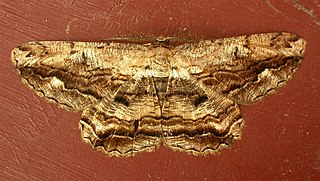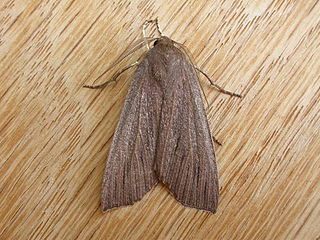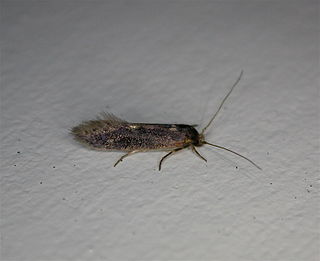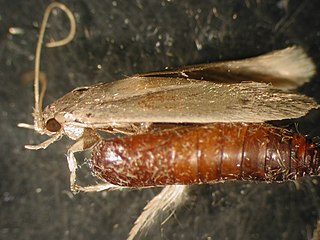
The brown-tail moth is a moth of the family Erebidae. It is native to Europe, neighboring countries in Asia, and the north coast of Africa. Descriptions of outbreaks, i.e., large population increases of several years duration, have been reported as far back as the 1500s. The life cycle of the moth is atypical, in that it spends approximately nine months as larvae (caterpillars), leaving about one month each for pupae, imagos and eggs. Larvae (caterpillars) are covered in hairs. Two red spots on the back, toward the tail, distinguish these species from other similarly hairy moth larvae. The winged adults have white wings and a hairy white body with a tuft of brown hair at the tip of the abdomen. Females lay one egg cluster, usually on the underside of a leaf of a host plant. The species is polyphagous, meaning that it feeds on many different species of trees, including pear, apple, maple and oak.

Coscinocera hercules, the Hercules moth, is a moth of the family Saturniidae, endemic to New Guinea and northern Australia. The species was first described by William Henry Miskin in 1876.

Mythimna separata, the northern armyworm, oriental armyworm or rice ear-cutting caterpillar, is a moth of the family Noctuidae. It is found in China, Japan, South-east Asia, India, eastern Australia, New Zealand, and some Pacific islands. It is one of the major pests of maize in Asia. The species was first described by Francis Walker in 1865.

Scioglyptis lyciaria, the white-patch bark moth, is a moth of the family Geometridae that occurs in Australia. The species was first described by Achille Guenée in 1857.

Opogona comptella is a moth of the family Tineidae. It is found from southern Queensland to Tasmania as well as in New Zealand.

Palleopa is a monotypic moth genus in the family Geometridae. Its only species, Palleopa innotata, the finely-streaked crest-moth, is known from Australia, including Tasmania. Both the genus and species were first described by Francis Walker in 1866.

Opogona is a genus of the fungus moth family, Tineidae. Therein, it belongs to the subfamily Hieroxestinae. As it includes Opogona omoscopa, the type species of the now-abolished genus Hieroxestis, it is the type genus of its subfamily.

Opogona omoscopa is a moth of the family Tineidae.

Opogona sacchari, the banana moth, is a moth of the family Tineidae. The species was first described by Wenceslas Bojer in 1856. It is native to the humid tropical and subtropical regions of sub-Saharan Africa, where it is also found in Madagascar, Mauritius, Réunion, Rodrigues Island, the Seychelles and St. Helena. It was first reported from the Canary Islands in the 1920s. In the 1970s, it was introduced into Brazil and Central America, and also appeared in Europe. It has been reported from Florida since 1986.
Opogona aurisquamosa is a moth of the family Tineidae. It has been recorded from the Pacific, including Easter Island, the Marquesas, the Society Islands, Fiji, the Kermadec Islands and Hawaii. It may have been dispersed by the Polynesians as well as by Europeans.

Gesonia obeditalis is a species of moth of the family Noctuidae first described by Francis Walker in 1859. It is found from eastern Africa, the Seychelles, the Maldives and the Oriental tropics of India, Myanmar, Sri Lanka east to the Philippines, the Sula Islands and Australia. The adult moth has brown wings with a scalloped dark brown band near the margin. The hindwings are similar in pattern to the forewings but are a paler shade of brown.
Pingasa cinerea, the tan-spotted grey, is a moth of the family Geometridae. The species was first described by William Warren in 1894. It is found in the Australian states of New South Wales, Queensland, Tasmania and Victoria.
Opogona isotalanta is a moth of the family Tineidae. It is found in Sri Lanka.
Opogona trichoceros is a moth of the family Tineidae. It is found in New Guinea.

Uromycladium tepperianum is a rust fungus that infects over 100 species of Acacia and related genera including Paraserianthes in Australia, south-east Asia, the south Pacific and New Zealand. The acacia gall rust fungus species Uromycladium tepperianum has been introduced to South Africa as a biological control on the invasive Australian shrub Acacia saligna.
Opogona flavofasciata is a moth of the family Tineidae. It is found in the India (Calcutta), Sri Lanka and the Philippines.

The Hieroxestinae are a subfamily of moths of the family Tineidae.












